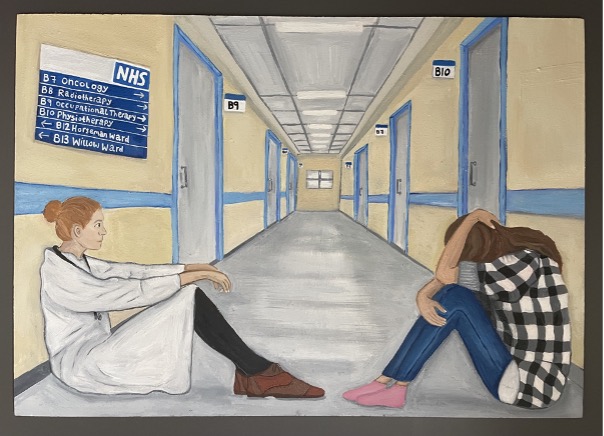On my level
In the scenario, the patient had severe back pain, and felt unable to sit down due to this. Without thinking, the consulter stood up in order to make the patient feel more comfortable. Something so simple, and yet it put the patient at ease immediately.
More often than not, medicine as a whole is utterly complex, for both the doctor and the patient. It can feel overwhelming. I wanted to create a piece that represents the very basis of a doctor-patient relationship – compassion.
Getting on the patient’s level, something that can seem so minimal, can be so important to a patient. Whether that means sitting down at the patient’s level in a chair by their hospital bed, or sitting on the floor with a patient while they cry, getting on a patient’s level is a simple yet clear show of compassion.
Both physically and mentally re-adjusting our viewpoint can make all the difference. Remembering that we ourselves could one day be in the patient’s position. Taking the time to view a situation from a patient’s perspective can make us better doctors, as well as better people.
Highly Commended for the annual EC Creative Prize
Comments
Add legacy comments here

I really like how this piece explores a concept so simple, yet small actions such as getting on the same level as a patient can go a long way in making them feel comfortable with a doctor rather than intimidated. Compassion is so important and I feel like it is at the basis of all of our actions as a doctor, and this piece portrays it really well!
I absolutely love this piece- something so small having such a huge impact on the patient. I love how it shows that something we don’t think about much e.g our body language can instantly put a patient at ease and make them feel more comfortable. I love how it shows such a little moment that is somehow so important, yet so neglected, and really makes you feel the impact of such small actions. Additionally, it shows the kindness and patience that underpins the entire medical profession- this piece highlights that perfectly.
I really enjoy this piece, as it portrays such a central concept of the medical field. The use of a real life example to inspire this is really touching, as it emphasises the importance of compassion and care on patient care. There is usually seen to be a power difference between doctor and patient, so I love how this shows the importance of the doctor appearing to be on the same level as a patient. It highlights the need for doctors to have many skills apart from knowledge, and that a doctor taking time to talk to a patient with care can help the patient in so many ways – whether it being allowing them to open up and truly express what is upsetting them, or being someone to talk to. Therefore, I really like how this piece underpins key values for a doctor
The piece really conveys the importance of the doctor-patient relationship. It highlights the effect of small actions towards patients, such as simply getting on the same level (physically and even emotionally) as the patient. Actions like these not only put the patient at more ease, but makes the patient more comfortable to disclose their struggles. The art piece steers away from the paternal approach, highlighting the importance of compassion in the healthcare environment
I love how this piece simply yet accurately reflects the need to build a strong patient-doctor relationship and what you’re able to physically do in order to build it. It highlights the importance of mirroring a patients body language to make them feel more comfortable when within a hospital environment, a key quality necessary to portray as a doctor. What seems to be a simple act of getting onto the same physical level as your patient is in reality so much more, as it is also building the emotional connection with them to provide a better quality of care. I appreciate how this art piece depicts this well!
I love how this image beautifully captures the humility that truly compassionate doctors bring to their practice, regardless of their vast knowledge. By sitting eye-to-eye with the patient, the doctor steps away from a paternalistic stance, creating a simple yet powerful connection that encourages openness and trust. This posture reflects a deep respect for the patient’s experience, acknowledging their pain and valuing their voice.
I find that this piece of art offers a striking and tender portrayal of empathy in healthcare. It emphasizes the importance of the doctor-patient relationship and the role of body language in conveying compassion, humility, and the creation of a safe space for trust and comfort.
The physical act of the doctor sitting on the floor, lowering their level to the patient’s eye level, is a simple yet powerful gesture. It highlights the shift in power dynamics from a paternalistic approach to the more modern, shared-decision model in medicine. This change in dynamics allows the patient to feel seen, heard, and respected during a vulnerable moment, while also symbolizing the doctor’s commitment to being present and compassionate. The gesture breaks down barriers that might otherwise exist between doctor and patient.
However, the true beauty of this piece lies in its simplicity. It captures a compassionate act, with a clear message: that even the quietest form of compassion can make all the difference.
I love how this piece simply and effectively depicts the importance of non-verbal communication and compassion in maintaining the doctor-patient relationship. It is the little things that matter- bringing yourself to the same level as a patient could really positively effect how a consultation goes, allowing it to feel more like a two-way conversation and partnership. The piece highlights how a little kindness goes a long way, and is able to change the trajectory of a consultation despite it being something so easy to forget.